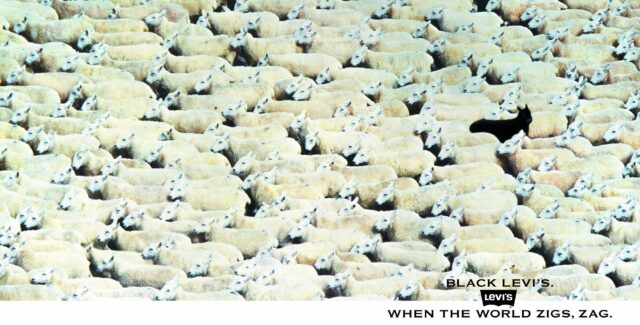In 2024, you’d be forgiven for thinking that getting great creative work is a doddle. After all, you can even ask AI to do it nowadays, right? And you don’t even need to ask, really – you can just “prompt” and…voila, amazing output.
Well, spare a thought for the user who, in 2023, asked genAI to show them ‘salmon in the river’ and got this absolute work of art in return…

Aside from the issues with the technology, it laid bare a wider problem: that communication with creatives—be they human or machine—is absolutely crucial to delivering top-tier creative work. Even the slightest misstep can derail an entire project before it even begins. So, how do you make sure you’re doing it well?
The brief is gospel
All design work starts with a brief, and too often this stage is overlooked as a simple piece of admin; a thing that needs doing in order to get to the good stuff, like doing the food shop before you attempt your own Michelin star masterpiece.
But how do you know what ingredients to buy if you haven’t nailed your recipe first? How do you know if you even have the right equipment? Or the space in your kitchen? Or what if there’s some specialist culinary skill that you can’t even pronounce, let alone attempt? Your brief isn’t robust enough if you thought it would sort itself out once you got going.
Adopting this mindset will mean you don’t clear the first hurdle. Because, simply put, the brief is sacrosanct. Even with kick-off meetings, or face-to-face chats (all of which can be challenging in a remote-first world) the design brief is the single connection that any creative team has to the project, at any given moment. Every decision that gets made could, and should be held up against that document and become subject to intense scrutiny concerning it.
So, that document needs to be crafted with consummate levels of care and clarity. At Hallam, we use Magic Briefs to ensure they actually get used. A good brief should cover the following:
- A clear objective for the work (why are we doing this thing?)
- The key audience (who are we doing this thing for?)
- Scenario (an example of the above in action)
- Any key principles (anything of the utmost importance we need to keep in mind)
Before any work begins, the best creative teams will prod your thinking and offer challenges in a bid to look for any gaps in it. We don’t do this to be obtuse; we do this because we know that, once agreed by all involved, this document becomes the guiding light for the entire project, so it needs to be bulletproof.
You’ve nailed the brief, what now?
With the perfect design brief, your friendly neighbourhood creative team can now leap into action and get cracking with the simple task of producing something special. But what happens next, and what can you do to ensure it’s truly special?
Have patience
The creative industry is one of the more bizarre sectors to work in. Primarily because our entire working society is geared to deliver productivity in an efficient and effective manner…but creativity doesn’t always work like that. Sure, we all have our process, and sometimes great ideas come quicker than others, but the common factor for great creative output is always time.
Time to think, time to dwell, time to play. Great creative teams even need time to do nothing, so that our minds can wander and approach things from different and unexpected angles. That might mean patience is required.
Be involved
I’ve already talked about how important the design brief is to a creative team – but it can be augmented further by that team having access to the experts. No designer will ever know more about your business than you do. So, if you want the best creative output, try to be available for the people tasked with delivering it. Let us ask questions of you, or float ideas by you as we have them. Your input in these fledgling stages can help cull weaker shoots and it can shape good ideas into great ones. Expect to talk about half-baked stuff and—at times—ideas that may make you question our sanity (that’s actually the sweet spot where the best work often lives).
Give clear feedback
Feedback is crucial to pushing creative work through to completion. And good feedback can elevate it to even headier heights. Conversely, though, poor feedback can have a negative impact on creative work. Here are my top tips for maximising your input in creative work:
- Leave all egos at the door – Good creatives don’t bring their egos to work. We don’t fall in love with our ideas and we try to keep subjectivity out of our thinking. We need the same from anyone giving us feedback – so if you’re unable to frame your feedback through the lens of the brief then it’s probably subjective.
- Radical candour – Similarly though, don’t dance around the feedback you want to give us. If it’s objective then it won’t conflict with the first point and you need to be clear with your issues. If you’re vague or overdress your point, then that ambiguity leaves room for misinterpretation. Care personally, challenge directly.
- Use whatever language you want – Feedback is all about communication, and sometimes it can be really difficult to find the words that properly capture what you mean. Don’t be afraid to get weird with your language, but expect follow-up questions that will try to tease out the inherent meaning behind what you’re saying.
- Feedback can be positive, too – Not all feedback has to be negative. Egos aside, telling us something you like about a piece of work helps sharpen our thinking and impacts our decision-making in other areas. It helps us anticipate how you’ve interpreted the brief so that the output can be aligned.
With a rock solid brief and a laser-guided approach to feedback, you will optimise working with your creative team and produce better results with more efficiency. What’s not to love!?
See how our creative team can help
Got a tricky problem to overcome? Or a difficult objective to hit? Or just need some creative thinking in your life? Contact us today




